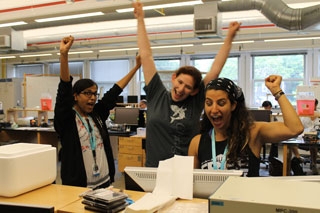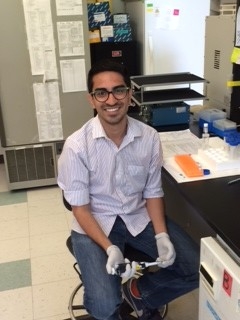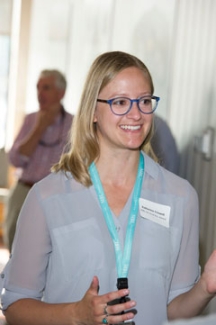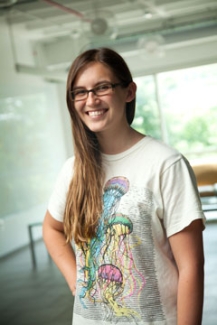University of Chicago Graduate Student Research Awardees Discover the MBL

Six University of Chicago graduate students are discovering the MBL this summer or fall as inaugural recipients of University of Chicago Graduate Student Research Awards, an ongoing program arising from the MBL-UChicago affiliation.
The students’ doctoral research topics at UChicago are diverse, ranging from evolutionary development to cell migration to indoor microbial communities. At the MBL, they have the opportunity to enhance their research programs by enrolling in a summer course and/or undertaking research with an MBL mentor.
“I am guessing at least one of you will have a transformative experience at the MBL, and will come back here for the rest of your life,” said Jonathan Gitlin, MBL’s deputy director of Research and Programs, at a breakfast honoring the 2014 MBL Research Awardees, including the UChicago graduate students.
While the UChicago students, like many before them, may have a career- or even life-changing experience at the MBL, the benefits are reciprocal, Gitlin said. “The MBL-UChicago affiliation is wondrous and potentially magical, from the perspective of shared intellectual capital,” he said. “It only adds to the MBL’s wealth, which lies in the essence of basic scientific discovery.”
The research awards are among the many connections being formed among MBL and UChicago students, scientists, and faculty members. Also this summer, eight UChicago undergraduates pursued scientific projects at the MBL as Metcalf students.
Below are brief profiles of the first six University of Chicago Graduate Student Research Awardees. The deadline to apply for the next round of awards is December 1, 2014. Additional opportunities to apply will be available in 2015.
Kamil Ahsan is a second-year graduate student at the University of Chicago advised by Victoria Prince, Professor of Organismal Biology and Anatomy. The UChicago research award allowed Ahsan to take the MBL’s Zebrafish Development and Genetics course, an intensive two-week program that familiarizes students with this powerful model organism and trains them in fundamental and novel zebrafish research techniques.
In Chicago, Ahsan is studying collective cell migration processes in embryonic development, in which groups of cells move together to form organized tissues. He is using zebrafish embryos to investigate how these cells regulate the directionality of their movement.
Ahsan was particularly interested in the microscopy and imaging components of the MBL course, which exposed him to new ways of visualizing migratory cell populations. In addition, the course’s training in developmental biology and genetic screening techniques will be valuable in his thesis work going forward.
“Gaining this experience relatively early in my graduate career will accelerate my research progress and enable me to take a more sophisticated approach to the experimental goals of my thesis work,” Ahsan wrote.
Chicagoans past and present were reunited through Katharine Criswell’s research award at the MBL this summer. Now in her third year of graduate work with advisor Michael Coates, Professor of Organismal Biology and Anatomy, Criswell is using both paleontological and developmental approaches to study the centrum, a part of the vertebral column, across the major groups of fishes. “I am looking at how many times the centrum independently evolved: it looks like at least nine times,” she said. “I am also interested in how it develops in the groups of fish that evolved it independently.”
Criswell’s research mentor at the MBL this summer was J. Andrew Gillis of Dalhousie University, who received his doctorate in 2009 in the lab of Neil Shubin, Robert R. Bensley Professor of Organismal Biology and Anatomy at UChicago. Gillis has been using skate embryos from the MBL’s Marine Resources Center for several years to explore the evolution of the vertebrate body plan, and has pioneered experimental techniques in skates that he taught to Criswell.
“Studying skates is perfect for me, because they belong to one of the groups (the chondrichthyans) that evolved centra independently of bony fish,” Criswell said.
Criswell also took the MBL Embryology course, a six-week, intensive course in advanced developmental biology. She is trained as a paleontologist, so the course gave her exposure to numerous new experimental techniques. “I learned so much!” she says. “I also got to follow the early development of so many different organisms—starfish, sea urchins, chicks, different types of worms, zebrafish, frogs—the list goes on and on. Now I know better what types of experiments you can do in each system (organism), and which systems are really good for different sorts of questions.”
Spending time at the MBL had been on Hilary Katz’s bucket list for several years.
“Since I went to school at Mt. Holyoke College in Massachusetts, I had heard about the MBL and knew I wanted to try to get out here sometime,” she said.
Katz is a second-year graduate student with advisor Melina Hale, Associate Professor of Organismal Biology and Anatomy at UChicago. The research award provided Katz with funding to attend Neural Systems and Behavior (NS&B), one of the MBL’s laboratory-intensive summer courses.

While Katz is still in the early stages of her Ph.D.—she will present her thesis proposal at the end of the summer—the NS&B course provided an opportunity for inspiration. “I knew this course would be a really cool opportunity to do things that my lab didn’t necessarily do and I would learn new techniques and approaches that I could apply to my own research,” she said.
Katz’s proposed thesis project will investigate the startle response in zebrafish and how it changes throughout development.
The small size of the MBL was “the perfect setting to make connections,” Katz said. “If I ever want to try a new technique [in the future], I know the NS&B faculty will be more than happy to have me contact them and ask for advice.”
Simon Lax has been given a chance to take his research in a new direction.
Lax is a third-year graduate student with advisors Jack Gilbert and Cathy Pfister, both faculty in the Department of Ecology and Evolution at the University of Chicago. There, Lax’s research has focused on microbiomes (microbial communities) in built environments, such as homes and hospitals. However, he hopes to branch out in his Ph.D. dissertation to investigate the ecological role of plant-associated microbes.
“Since no one in my department works on anything similar, this research award is making the project possible,” says Lax
Lax will work at the MBL this fall with Senior Scientist Anton Post, an expert on plant-microbiome relationships in marine environments. Lax will be studying the microbial communities associated with the freshwater aquatic plant Lemna minor (common duckweed), which is in widespread use for phytoremediation (the use of plants and their associated microbiomes to remove or degrade environmental pollutants). He is particularly interested in the effects of cadmium, a heavy metal and significant source of aquatic pollution, on the Lemna microbiome. Lax will have access to electron microscopy and chlorophyll fluorescence imaging technologies at MBL to get his project up and running.
Darcy Ross learned new laboratory techniques and jump-started her thesis work at the MBL this summer.
Ross is entering her third year of graduate study with advisor Neil Shubin in the Organismal Biology and Anatomy department at UChicago. Her proposed thesis project addresses evolutionary patterns in the development of shell shape in Crepidula, a genus of sea snail.
“It seems like the ancestral snail shell was coiled, but you see repeated evolutions of flat, limpet-like shells. I’m trying to figure out if there’s a similarity in mechanism in generating these limpet-like shells,” Ross said.
Ross attended the MBL Embryology course followed by a week of independent research with Jonathan Henry of the University of Illinois, who is an external member of Ross’s Ph.D. committee. Henry, an expert on Crepidula, is a faculty member in the Embryology course and visiting investigator at the MBL. Henry taught Ross certain techniques for using Crepidula as a model system that she can later apply to studying development in other organisms.
“Some of my work here was prep for analysis that I’m going to do later,” Ross said. Because snails are so plentiful at the MBL, she fixed snail embryos in various stages of development, and then shipped them home for further research.
Jiajie Xu also attended the MBL Embryology course through a University of Chicago Graduate Research Award.
Xu is a third-year graduate student with advisor Rick Fehon, Professor and Chair of Molecular Genetics and Cell Biology. While Xu works primarily with fruit flies (Drosophila) in the Fehon lab, the Embryology course exposed him to a wide range of model organisms and techniques in developmental biology.
“Here, we can really work with and observe the developmental programs of all kinds of species, both vertebrates and invertebrates. It really helped me to understand how different organisms use different strategies to achieve the same goal,” Xu said.
For his doctoral thesis project, Xu is examining how fruit flies control the size of their imaginal wing discs—paired structures in fly larvae that eventually give rise to the wings.
“Other organisms also need to control the size of their organs,” he said. “I can get some insights from other [organisms] to tackle the same question.”


